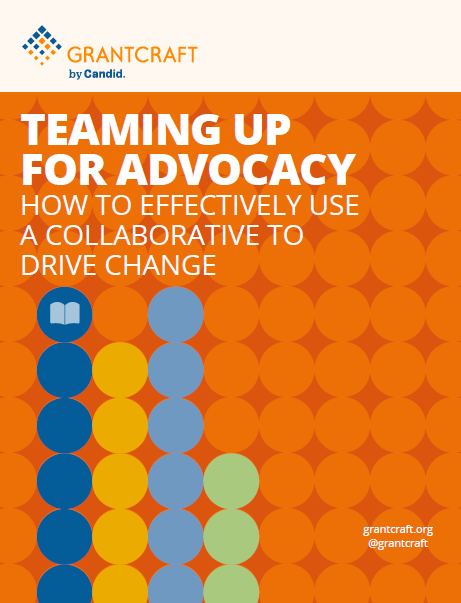Teaming Up For Advocacy How To Effectively Use A Collaborative To Drive Change
This guide captures the wisdom of philanthropic leaders who have participated in multi-party advocacy collaboratives. It synthesizes information to dig deeper and understand the pain points and levers of success tied to funding advocacy and donor collaboratives.
The series is intended for both seasoned funders looking to troubleshoot and strengthen work they’re doing in an existing advocacy collaborative, as well as funders thinking of dipping their toes in the water. Each bite-sized chapter is intended to make this work easy to reference and share, and to read as a full body of work or in pieces.
What's in the guide?
- Introduction. These framing thoughts share why funding advocacy is too often “the philanthropic road not yet taken” yet is likely to lead to the kind of change philanthropy seeks.
- What Are the Benefits of Being Part of an Advocacy Collaborative? Grantmakers are remarkably consistent about the benefits of participating in advocacy collaboratives. Here we explore the rationale leading funders to embrace this strategy.
- What Makes Advocacy Collaboratives Successful? This section outlines the key insights to successful advocacy collaboratives and how they contribute to stronger relationship building and effective grantmaking.
- Types of Advocacy Collaboratives. There are many forms to collaboratives and this section walks through a few formats and how they lend to different challenges and benefits.
- Groupthink. Collaboratives can be proactive in building preventive measures about groupthink into their processes from the get-go—this section digs into how.
- Personality Conflicts. This section talks about how to overcome an inevitable sticking point: personality conflicts. While this issue exists in many contexts, it can have unique consequences for policy collaboratives.
- Agreeing to Strategies. Achieving goals as a group can be overwhelming. There are several tactics and strategies funder collaboratives use to move the policy needle.
- Does Size Matter? Because policy work occurs across multiple levels, it is important that advocacy collaboratives involve and consider grantmakers working across multiple points.
- Grantee Roles and Relationships. This section highlights how grantees play a key role in the work of advocacy collaboratives and the necessity of addressing power imbalances between grantmakers and grantees.
- Do We Need Staffing? The most effective advocacy collaboratives are staffed in some way and there are several advantages to that. This section highlights what those are and how to get there.
- Chasing the Money. Like any fundraising, there can exist tension between the need to secure funding and maintaining a commitment to mission. This section discusses the balance of the two.
- “My Foundations is Nervous About Policy Advocacy” Even in funder collaboratives, there can exist feelings of worry or limitations to what funders can support. This section provides tips on how to move through those or decide what is the best role for a funder to play.
- Tool: Decision-Making Tree This tool is a guide for prospective funders considering if joining or establishing an advocacy funder collaborative is right for them, and if so, what structure it can take.

Categories
Content type
Strategies
Tags
Content series
This guide captures the wisdom of philanthropic leaders who have participated in multi-party advocacy collaboratives. It synthesizes information to dig deeper and understand the pain points and levers of success tied to funding advocacy and donor collaboratives. Each bite-sized chapter is intended to make this work easy to reference and share, and to read as a full body of work or in pieces.


